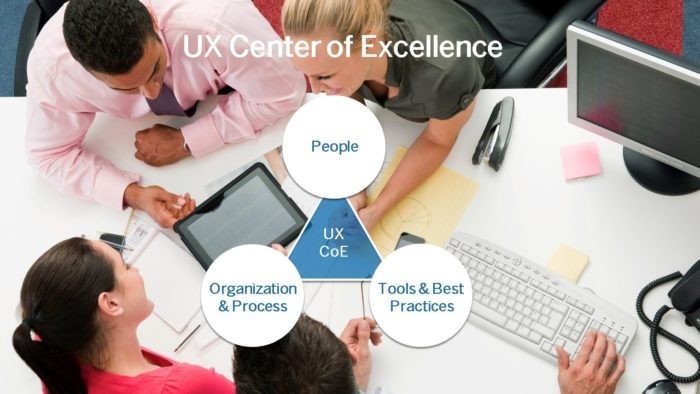your journey
Top 10 Tips to Set Up a UX Centre of Excellence
In our experience, about 50% of the screens our customers use are not developed by SAP but instead are adapted or developed by partners or the customer’s internal IT organisation. We also learned in more than 300 customer projects, that many IT organisations typically do not engage directly with their end users when they develop their own screens. Most of them do not have design experts at all. In the last 2 years, more and more IT organisations are building design competencies to institutionalise user experience (UX).
We believe the best approach to doing that is through a UX Center of Excellence (UX CoE). The goals of a UX CoE are to establish design as a competitive advantage; influence organisations and processes to include design methods; establish design skills and a design mindset; and provide relevant tools and best practices.

Here are 10 tips and tricks for establishing a UX CoE to ensure success:
- Get top management buy-in: Yes, it’s important to encourage a mindset shift from the bottom up. But for a UX initiative to succeed, you need budget and resources, which can only happen when you engage the top tier of the company.
- Make the business value of UX visible: The best way to get top management buy-in is to calculate the UX return on investment, which shows tangible evidence of its benefits. Your best bet is to come up with an ROI dollar figure, in the form of productivity gains, lower training costs, decreased user errors and reduced change requests.
- Involve key stakeholders: For UX to be taken seriously throughout the organization, UX cannot be an IT-only game – stakeholders from the business units must also be involved. The business and IT need to jointly define the organization’s goals for UX, and how these goals will be achieved.
- Prove value by involving end users in pilot projects: To keep interest and motivation high, companies should focus on success stories that can show fast value. Identify projects that can get users speaking positively about UX in a few months’ time.
- Enable learning by “doing:” No amount of lecturing can teach people about design and UX; the best way to experience the power of design is by “doing” it. You will realize the power of design and what it means to design for real user needs.
- Integrate UX with development processes: Design and development are often seen as two separate processes. One for designers and one for developers. To get it right you need to define ONE development process, where UX activities are an integral part. It requires a process in which these two disciplines are merged and work in close coordination with users.
- Visualize requirements before you implement: A picture – and in this case a screen mockup – is worth more than 1,000 words. This is the language that everybody understands: developers, designers, business experts, managers, customers and users. By visualizing the end result early in the process you will reduce the number of costly changes after a solution is developed. It is much easier and cheaper to change a screen mockup.
- Hire the right talent: UX requires new skills, including user research, interaction design, visual design and the ability to lead design-thinking workshops. Look for people with great communication skills, because designers often play a moderation role between developers, business experts and users.
- Provide tools and best practices: Tools (e.g. UI prototyping tools) and best practices (e.g. UI guidelines, templates) help to scale UX efforts in an organization. This will increase quality and efficiency and enable people to learn UX.
- Take your time: If nothing else, taking UX serious means change, and it won’t happen overnight. Plan for a step-by-step approach, in which you grow and learn.
So, who will benefit from a UX CoE? Pretty much any organization that wants to partake in UX. UX isn’t a magic potion that’s sprinkled over the user interface at the last minute; it requires a high level of maturity. We have helped several customers to set up a UX CoE which has led to a considerable increase in user productivity and satisfaction. By following these 10 tips and tricks, others can do the same.
Share this:

Neil ran his first SAP transformation programme in his early twenties. He spent the next 21 years working both client side and for various consultancies running numerous SAP programmes. After successfully completing over 15 full lifecycles he took a senior leadership/board position and his work moved onto creating the same success for others.